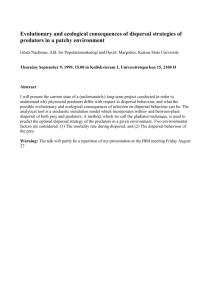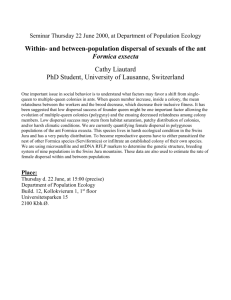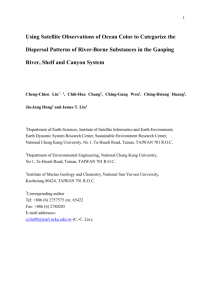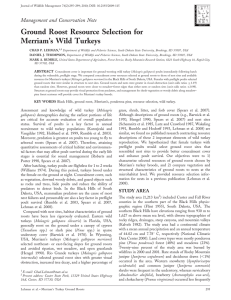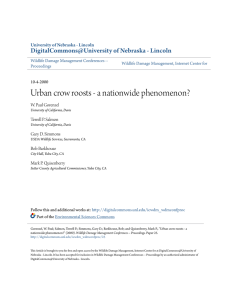Algorithmic Methods in Conservation Biology
advertisement
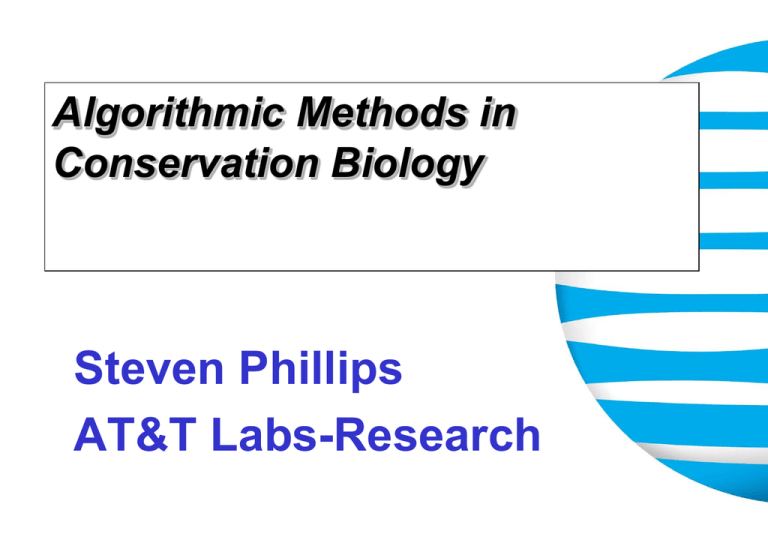
Algorithmic Methods in Conservation Biology Steven Phillips AT&T Labs-Research Vignettes: Data Models Policies • Species detection: tree swallow roosts from radar • Modeling species distributions – Challenge 1: Presence-only data (Maxent) – Challenge 2: Non-stationarity (STEM) • Planning protected areas to allow dispersal – Network flow, mixed integer programming • Thanks to Tom Dietterich, Rebecca Hutchinson & Dan Sheldon (Oregon State University) for many slides! 2 Dover, DE, 10/2/2010@6:52AM The Dream • Automatic detection of roosts at continent-scale on daily basis – Data gathering and repurposing • Unprecedented view of species distribution Source: NOAA – Spatial coverage – Temporal resolution • Analyze results to learn about – Roost biology – Migration patterns – Climate change • Data archived since 1991 [Winkler, 2006] Research by D. Sheldon & T. Dietterich (OSU) and D. Winkler (Cornell) Progress: Machine Learning • Challenging image recognition task! – Primarily shape features to-date – no temporal sequencing – High precision for roosts with “perfect appearance” – Variability in appearance is challenging low recall 100 positive examples Top 100 predicted roosts (shape features + SVM) Progress: Ecology • Locating roosts – Identifying roosts in radar images • Labeling efforts – Estimate ground location within a few km • Previously difficult task • 15+ roosts located in 2010-2011 – Oregon, Florida, Louisiana • Analysis of labeled data – Understand regional patterns – Roost growth dynamics • Very predictable • Potential species ID from radar! Florida Vignettes: Data Models Policies Species Distribution Models (SDM) SDM Challenge #1: Presence-only data Yellow-throated Vireo occurrence points … environmental variables Predicted distribution A solution: Maxent • • • Given: • Training examples x1, …, xn • Assumed to be from an unknown distribution π = P(x|y=1) • Environmental variables f1(x), …, fm(x) Find: • A good estimate of π (as a function of f1, …, fm) …and P(y=1|x) Method: L1-regularized Maxent • Maximum entropy principle: among distributions consistent with the data, prefer one of maximum entropy (Jaynes, 1957) • Consistency given by relaxed moment constraints: • | Eπ[fi] –∑j fi(xj)/m | ≤ βi • E.g., “mean rainfall must be close to mean rainfall at training examples” S. J. Phillips, R. E. Schapire and M. Dudík 2004; S. J. Phillips, R. P. Anderson and R. E. Schapire 2006 Application: Protected area design Application: Protected area design (a) Dracula ant (Mystrium mysticum) (b) Grandidier’s baobab (Adansonia grandidieri) (c) Common leaf-tailed gecko (Uroplatus fimbriatus) (d) Indri, the largest lemur species (Indri indri) Application: Protected area design Kremen et al., Science 320(5873), 2008, pp 222-226 Application: Invasive species Cane toad: known occurrences Cane toad: areas vulnerable to invasion Elith et al., Methods in Ecology & Evolution 1, 2010, pp 330-342. Application: guiding field surveys Figures by Richard Pearson, AMNH Application: guiding field surveys Target survey areas Highest priority Lower priority Chameleons (Brookesia & Chamaeleo) Leaf-tailed geckos (Uroplatus) Day geckos (Phelsuma) Application: guiding field surveys ? ? ? ? ? ? ? ? ? Results: new species of chameleon Calumma sp. 1 Calumma sp. 2 Results: new species of iguana, snake Oplurus sp. Liophidium sp. and others… Application: Giant exploding palm J. Dransfield et al., Botanical Journal of the Linnean Society, 2008, 156, 79-91. SDM Challenge #2: Non-stationarity • Problem: predictor-response relationships can change over space and time • A solution: Spatial-Temporal Exploratory Models (STEM) – Create ensembles with local spatial/temporal support – Base learner = classification trees • eBird – Citizen Science – Dataset publicly available for analysis – LOTS of data! • ~3 million observations reported this May STEM D. Fink et al., Ecological Applications, 2010, 20(8):2131-47 STEM SDM: Indigo Bunting Animation courtesy of Daniel Fink Vignettes: Data Models Policies Reserve planning for Protea Dispersal ~300 endemic species in the fynbos of the Western Cape of S. Africa Suitable conditions will shift under climate change Limited dispersal ability (ants, rodents…) Modeled distributions of Protea lacticolor Source: Hannah et al., BioScience, 2005 Shifting suitable conditions Interpretation: a patch of suitable conditions moving slowly enough to support the species over time Dispersal chain: – Sequence of suitable cells (one per time slice) – Physical distance between cells limited by dispersal ability The goal: find disjoint dispersal chains for each species: – At least 35 (100 km2) chains per species, if possible Minimize #cells with proposed protection – Union of all chains, non counting already protected P. Williams et al., Conservation Biology 19(4) pp 1063—1074, 2005 Dispersal as network flow in a layered graph cell suitable for species In this slice • • dispersal possibilities Path from source to sink = dispersal chain for one species With unit capacity arcs, an integral flow of size 35 represents a set of 35 non-overlapping chains S. J. Phillips et al., Ecological Applications 18(5), 2008, pp. 1200-1211 Solution: network flow and linear programming • Flow conservation constraints are linear • Integer variables: Preserve for each cell (0 or 1) • Exact solution of MIP: – Minimum possible number of protected cells to achieve the conservation goal Light grey: transformed Green: already protected Black: goal essential Orange: MIP solution Questions?


